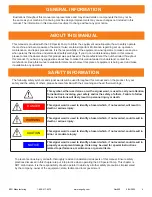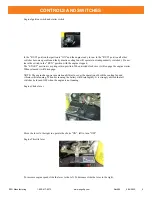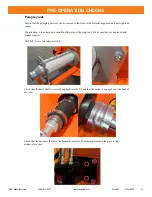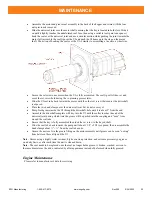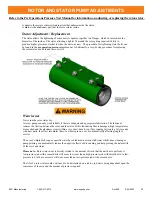
The pre-start pressure test check is a crucial part of pre-operation checks and must be
performed daily before pump operations can begin. This test is to ensure the correct operation
of the rotor-stator and to prevent unnecessary wear on the rotor-stator.
Daily Pre-operation Pressure Test
x
Start the engine and let idle.
x
Securely install the pressure test rig on the output flange.
x
Shut the ball valve on the pressure test rig.
x
Fill the hopper to a water level that is approximately 1" above the inner outlet opening. Add
approximately 1 tablespoon of a mild dish soap for every gallon of water. This provides a level of
lubrication for the dry rotor and stator making it easier to break free without damage.
x
Slowly adjust the throttle lever increasing the engine revs to maximum.
x
Set the speed control on the pump control panel to approx. 50%, then push the toggle switch to
the “FWD” position and observe the auger rotating inside the hopper in the forward direction.
The forward direction can be verified by briefly and quickly opening and closing the ball valve on
the pressure test rig to ensure water from the hopper is being pumped out of the unit.
x
With the ball valve closed observe the psi indicated on the pressure test rig gauge. 150 psi is
the recommended operating range. If the indicated psi is below 150 then adjustments to the
stator housing clamp is necessary.
Stator Housing Clamp Adjustment
Step 1:
Remove stator cover.
Step 2:
With the engine running as described in the previous section loosen the bolts
indicated by the number
3
. Start at one end and tighten the adjusting bolts as
indicated by the number
1
in the picture below. Tighten stator housing bolts evenly
to adjust the pressure on the pressure test rig. 1/4 to 1/2 turn each at a time is a
good place to start.
Step 3:
Observe the pressure on the gauge. If psi is below 150 then repeat step 1.
NOTE: Nuts and bolts adjusted during step 1 may become loose as the they are tightened
along the length of the stator housing clamp. These need to be re-tightened (snug)
before repeating step 1.
Step 4:
Once 150 psi is observed, tighten the bolts indicated by the number
2
in the picture below. These bolts
should be made snug before tightening to match step 1.
Step 5:
Tighten the bolts as indicated by the number
3
in the picture below. These are set bolts and
should be tightened slightly pass snug. This will prevent the stator housing clamp from
changing without adding additional pressure.
Do not overtighten adjustment bolts. If the engine is noticed “bogging down” during the
adjustment procedure, then the rotor-stator is becoming too tight to operate efficiently. If bogging
down is noticed during the adjustment procedure or 150 psi cannot be achieved the rotor-stator
needs to be replaced.
3
3
3
1
1
2
1
2
1
1
1
DAILY PRE-OPERATION CHECKS
EZG Manufacturing 1-800-417-9272
www.ezgmfg.com
Rev000 5/24/2022 17
!! IMPORTANT PROCEDURE !!


